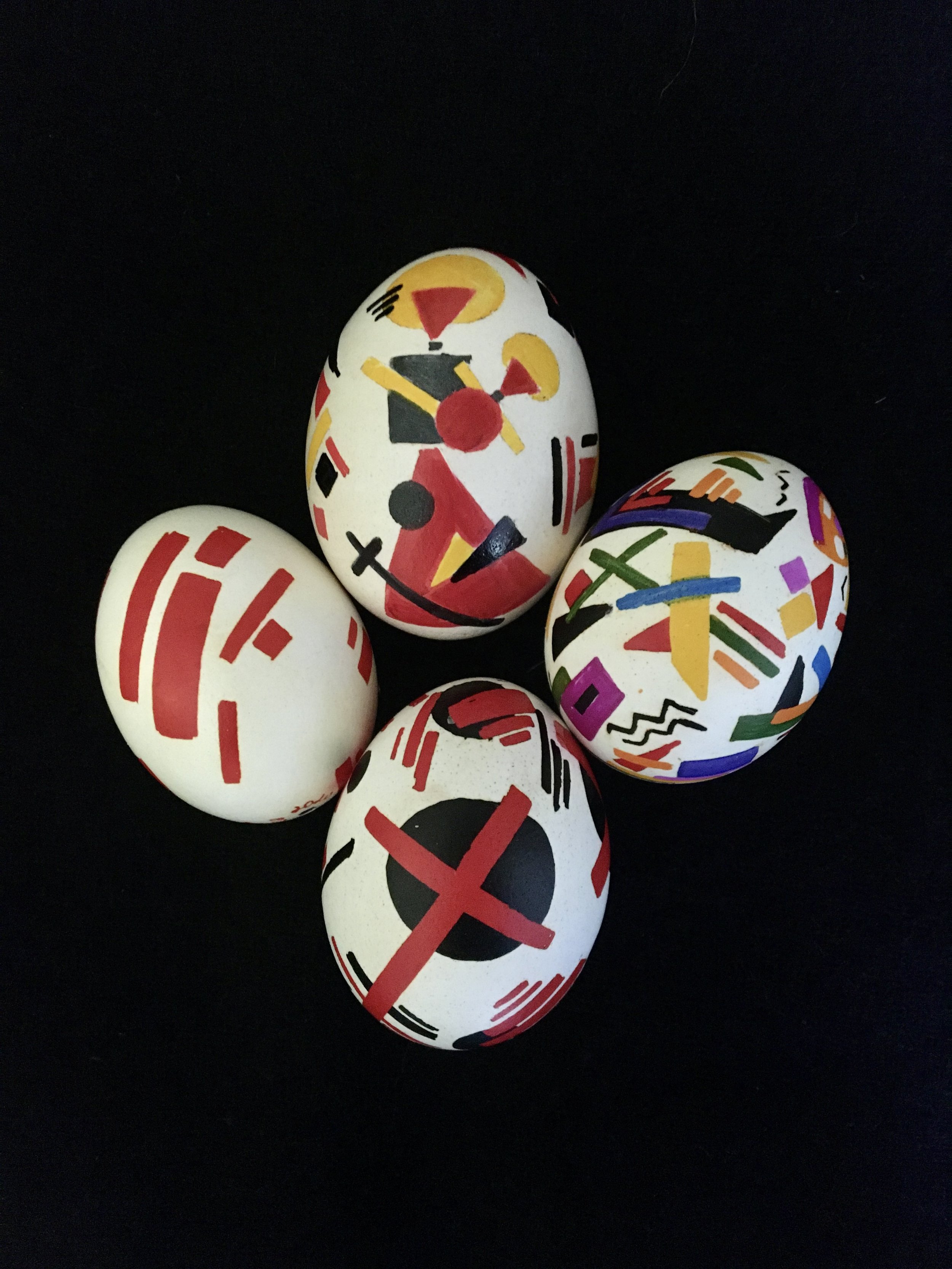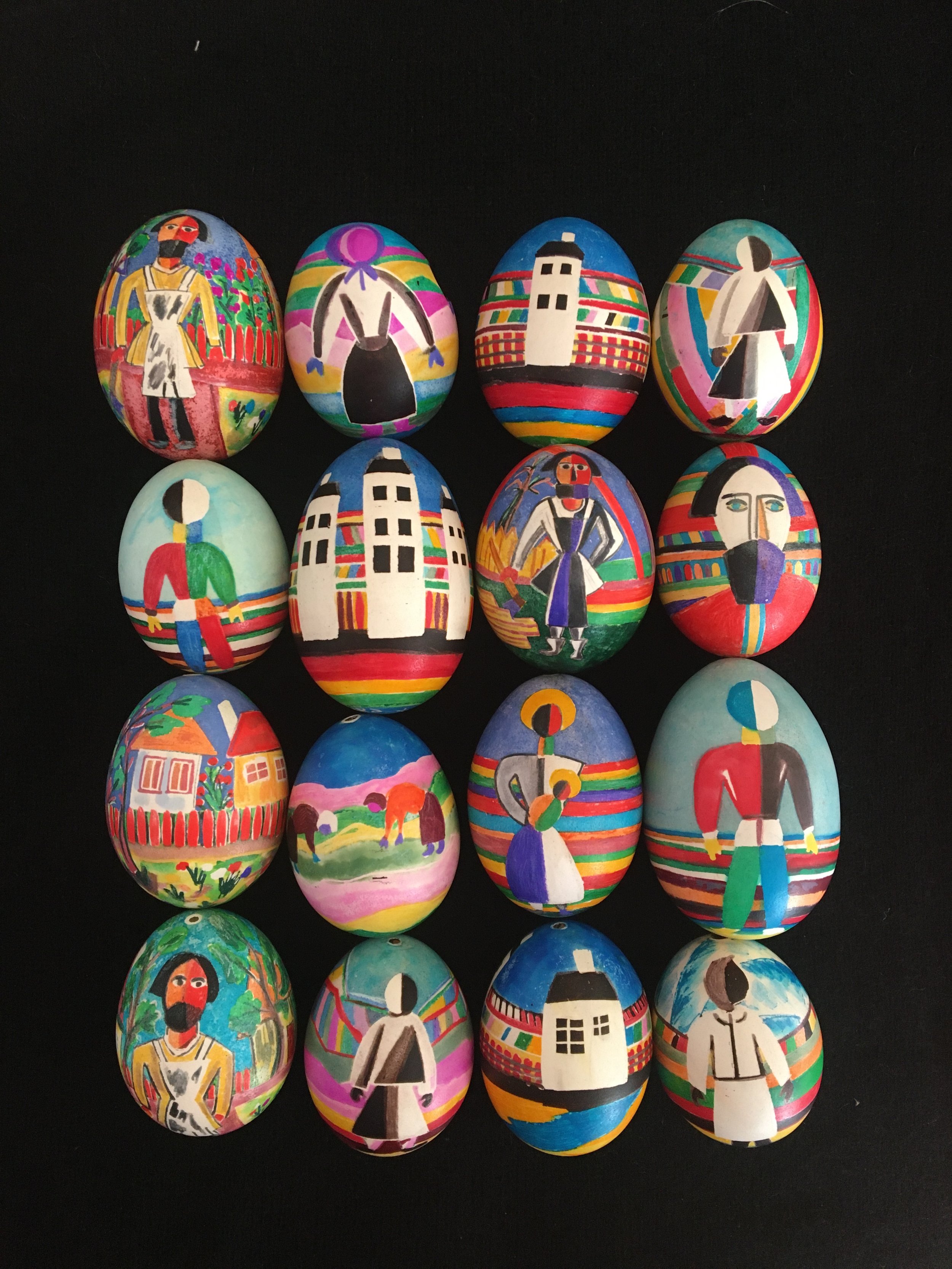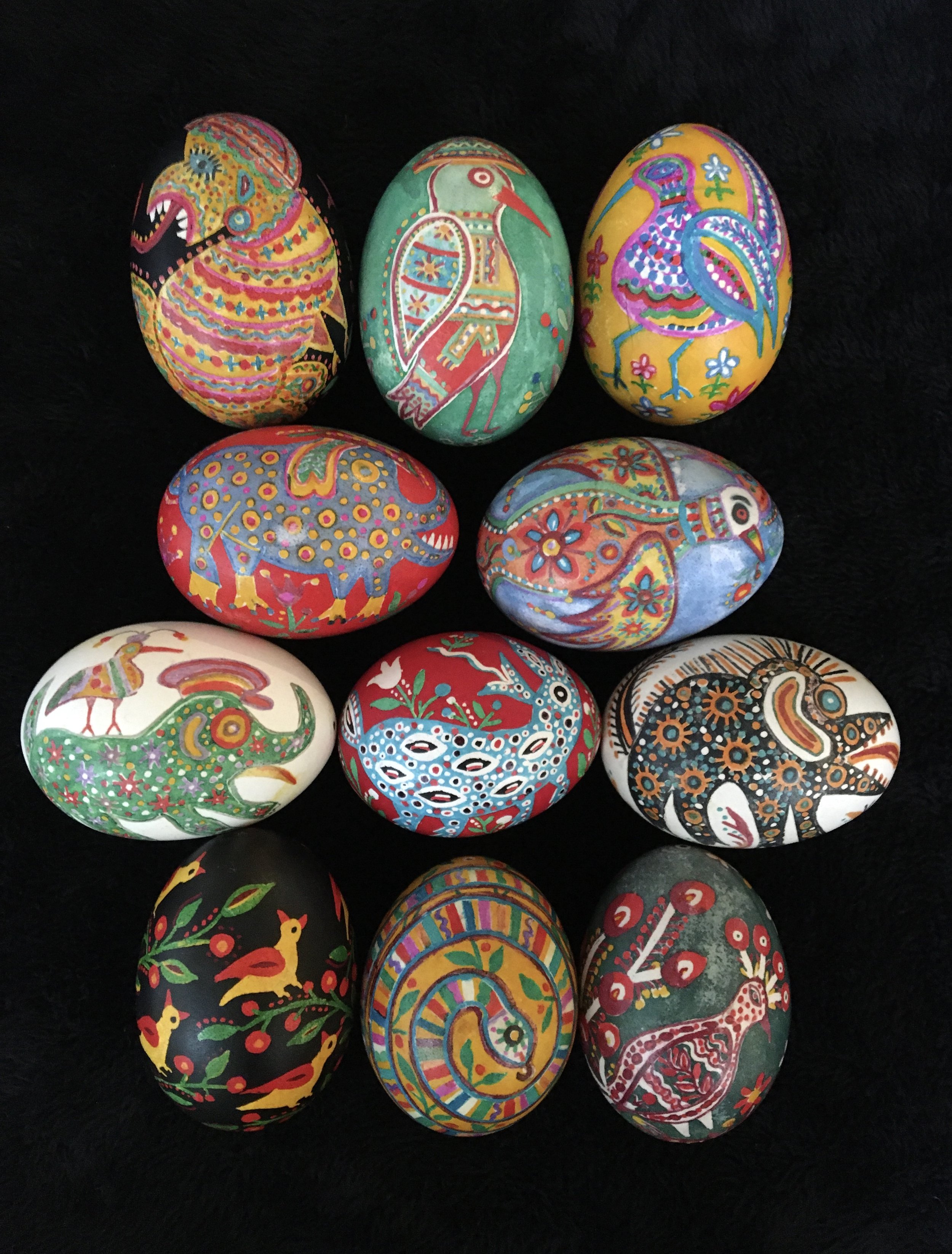A centuries-long tradition, a symbol of defiance
by Sofika Zielyk
I will go to the cemetery with a basket of Ukrainian Easter eggs in a few days. In my culture, it is a tradition to place these eggs, called pysanky, and Easter bread on the graves of departed loved ones so that we can symbolically partake in the Easter feast together. This year, however, will be a little different. As I gently place an egg on my grandfather’s grave, who fought for Ukrainian independence in the 1920s, I can’t help but think of present-day Ukrainian soldiers who died defending their homeland from Russia’s full-scale invasion. My grandfather and these soldiers are separated by a century, yet the enemy remains the same.
As a folk artist and ethnographer specializing in Ukrainian Easter eggs, I have spent much of my life researching, practicing, and popularizing this ancient folk art. Yet, the tragic events of the past year made me realize how far this custom has evolved since its emergence many centuries ago. I am astonished that this pagan tradition has managed to maintain its relevance in our chaotic world.
The Ukrainian tradition of decorating eggs during springtime has persisted for hundreds of years and is widely recognized as a folk-art ritual that symbolizes the Easter holiday. Pysanky – or pysanka in the singular – are gifted, collected, displayed, and cherished, while classes teaching this folk-art form are held worldwide. However, behind this generally familiar description of the Ukrainian Easter egg, there is a deeper story that touches upon the ancient origins of pysanky.
Thousands of years ago, the agrarian people living on present-day Ukraine's territory revered the sun as one of their most important gods and created rituals to honor this deity. The sun provided them with light and warmth, life’s essentials, and made their crops grow. The humble egg played a vital role in celebrating pagan spring rituals welcoming the return of the sun and nature after a long, dark winter. The egg was believed to possess enormous power, and holding one was a way of harnessing the sun's energy. The egg represented the rebirth of nature, while its yolk symbolized the all-powerful sun god. These decorated eggs were revered as talismans and believed to protect against evil, disease, and fire and to bring good luck, health, wealth, and a bountiful harvest.
Making pysanky was a task entrusted to women; therefore family designs, secret recipes for natural dyes, and chants or prayers were passed down from mother to daughter through the centuries. Women sat down to their task in the dark of night and asked the gods for fertility by depicting a chick on the egg, for health through a pine branch, or for strength and prosperity with horses. The earliest pysanky depicted randomly-placed symbols using the batik-wax resist technique. Artistry was unnecessary as long as the sun god could interpret the symbols. The eggs were not meant to be kept for long periods and were often used for various purposes; they were placed in beehives for continuous honey, buried in the ground for a better harvest, or mixed into cattle feed to ensure healthy livestock.
When Ukraine embraced Christianity in the 10th century A.D., many aspects of paganism were incorporated into the new religion, and the pysanka tradition transformed from a spring ritual celebrating the return of the sun god to the return of the Son of God from the dead at Easter. Old symbology gained a new meaning: the triangle, which represented birth, life, and death, now depicted the Holy Trinity. Grapes, which in the pagan tradition, were a sign of good harvest, now represented the growing new faith.
In the mid-19th century, as the world was experiencing the “Spring of Nations”, Ukrainian ethnographers and folklorists began documenting the peasant way of life, including the pysanka tradition. Legends, myths, and symbolic patterns passed down orally through generations were recorded for the first time and formed the basis of what we now know as "traditional" pysanky.
However, the tradition declined in Ukraine during the 20th century due to efforts by the USSR to wipe out ethnic differences among the nations it had colonialized. Moscow aimed to create a common Soviet culture that would eventually erase all traces of diversity and result in a homogenized population. While certain expressions of folk art were allowed to flourish, it was relegated to folk festivals as a quaint relic of peasant traditions.
Despite the Kremlin’s efforts, the tradition of making Ukrainian Easter eggs survived and was preserved by Ukrainian immigrants and refugees who brought their culture and traditions abroad. During the late 19th and first half of the 20th century, several waves of Ukrainians emigrated in search of a better life to escape the Nazis and then the Soviets after World War II. They brought their ancient cultural tradition, giving rise to the "diasporan" pysanka. While diaspora ethnographers, folklorists, and museums continued to preserve old Ukrainian pysanka designs, their understanding of it as a talisman or symbol of protection gradually faded. Instead, the focus shifted to the intricate artistry and perfection of the egg's design, with little emphasis on its symbolic patterns.
In the late 20th and early 21st centuries, a new phase of the tradition emerged: the "artist's" pysanka. Artists began using the egg as a canvas for anything imaginable, from landscapes and portraits to Christmas scenes and even the Statue of Liberty. While not necessarily made for the Easter holiday, these decorated eggs were admired for their intricate batik technique and use of eggshells as a medium, earning them the name of pysanky.
As a first-generation American daughter of Ukrainian refugees, I started my career creating diaspora-style pysanky and was generally unaware of the egg’s ancient history. After reading a book about centuries-old pysanka designs, I began my journey into the past, and the past then guided me into the future. I now work in parallel artistic tracks, creating traditional patterns and diasporan designs. Traveling the world has inspired me to consider that the traditional batik method of the pysanka could be utilized in a nontraditional way. As I browsed in an antique shop in the ancient city of Bruges, admiring the blue/white patterns of traditional Dutch ceramics, I was struck by the thought of how stunning two shades of blue would look on the snowy white background of an egg. I traveled to Paris to see a retrospective exhibit of Sonia Delaunay’s art, and it led me to create bright, colorful circular patterns on eggs reminiscent of her artistic style. Ukraine’s museums were also an exceptionally rich source of inspiration. While on a Fulbright scholarship in Kyiv, I sought out such Ukrainian-born artists as Kazimir Malevich, Maria Prymachenko, and Hanna Sobachko-Shostak, adding pysanky in their styles to my artist’s series.
I was in the middle of my Malevich-inspired series when Russia invaded Ukraine on February 24, 2022, and plunged the country into a brutal and devastating war. When the initial shock wore off, I realized that I had a secret weapon, the pysanka, which could be used in the service of cultural diplomacy. I remembered the ancient legend that said the world would exist only if pysanky continued to be created and, in response, conceived a communal exhibition of Ukrainian Easter eggs titled “The Pysanka: A Symbol of Hope.” The Ukrainian Institute of America and the World Federation of Ukrainian Women’s Organizations (WFUWO) partnered up with me for this project.
I asked people of all backgrounds, beliefs, and ages – including children – to contribute their traditionally-decorated egg to enrich a living installation of pysanky. Within a week, the first three arrived from Quebec, Canada, and to date, we have amassed close to 600 of them from a total of 13 countries. As more eggs continue to arrive, the installation grows not only in number but symbolic power. The final phase of “The Pysanka: A Symbol of Hope” project will bring all the decorated eggs to Ukraine, where they will be incorporated into the same ancient rituals that our ancestors practiced. Eggshell fragments will be mixed in with animal feed for healthier livestock, buried in the ground for a bountiful harvest, placed in the four corners of new homes being constructed for protection against evil, and left on the graves of children murdered during the war so they have something to play with in the afterlife. This project, as I envision it, is a primeval, cultural response to the aggressor.
As curator of this installation, I have been blessed to witness this centuries-long tradition evolve again to reflect our current reality. The pysanky sent to the installation include those created by seasoned artists, but mostly, they are from ordinary people. It is “folk” art in its purest sense, and the symbols are once again rich in meaning. People are approaching the creation of the pysanka with intent, just as it was thousands of years ago;
The authors of war-time pysanky are depicting sunflowers and wheat stalks in the hopes that Ukraine can once again become the breadbasket of Europe. The desire for freedom is shown with the liberal use of yellow and blue, the colors of the Ukrainian flag, and the tryzub, Ukraine’s coat of arms. The egg has once again become a symbol of rebirth – the rebirth of a country after war. The pysanka is a non-violent yet unyielding declaration of resistance, an artistic expression of defiance.
The tradition of creating pysanky has changed and evolved over the centuries. It has endured hopeful and dark times, including wars, serfdom, artificial famines, repressions, and occupations. Pysanky are, in many ways, a powerful metaphor for the resilience and determination of the Ukrainian people.
The world changed on February 24, 2022 – and so did I. Ancient pysanka patterns will always be my first love. And clearly, it is vital to recognize the differences between all branches of this art form. However, I am convinced that a tradition is a living, breathing thing that must evolve to stay relevant to a nation and its culture. When I go to the cemetery, I will visit the graves of family members and friends who are no longer with us and the heroes who have given their lives to Ukraine. I will decorate their final resting place with traditional pysanky, diasporan ones and even an egg or two from my artist’s series. My grandfather, however, will receive a blue and yellow “war” pysanka as a sign of the enduring connection between his past, my present, and Ukraine’s future.


